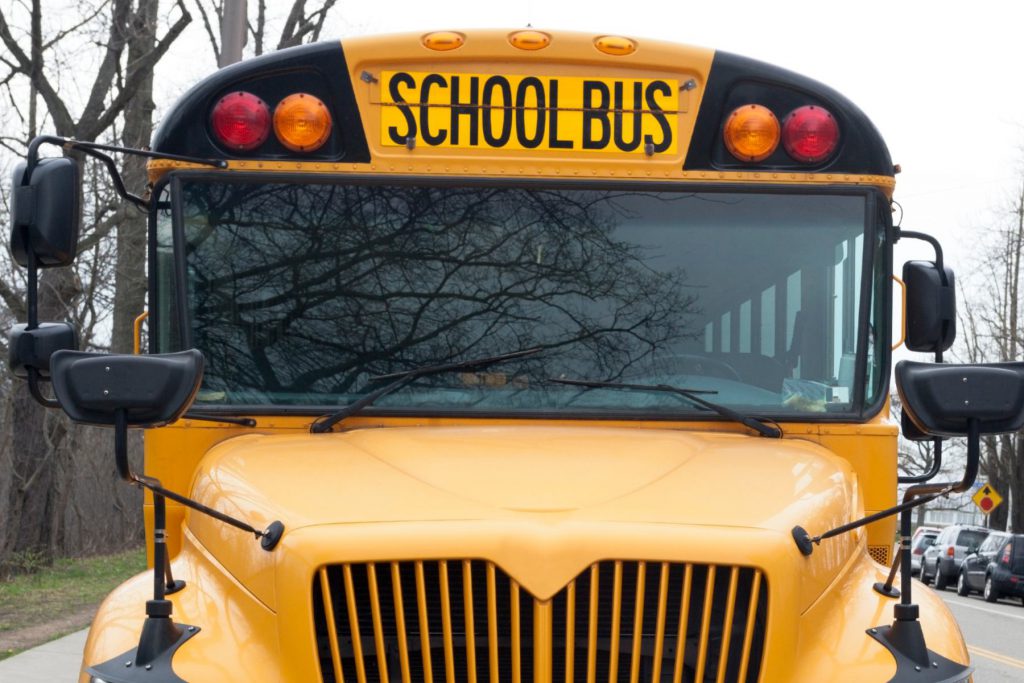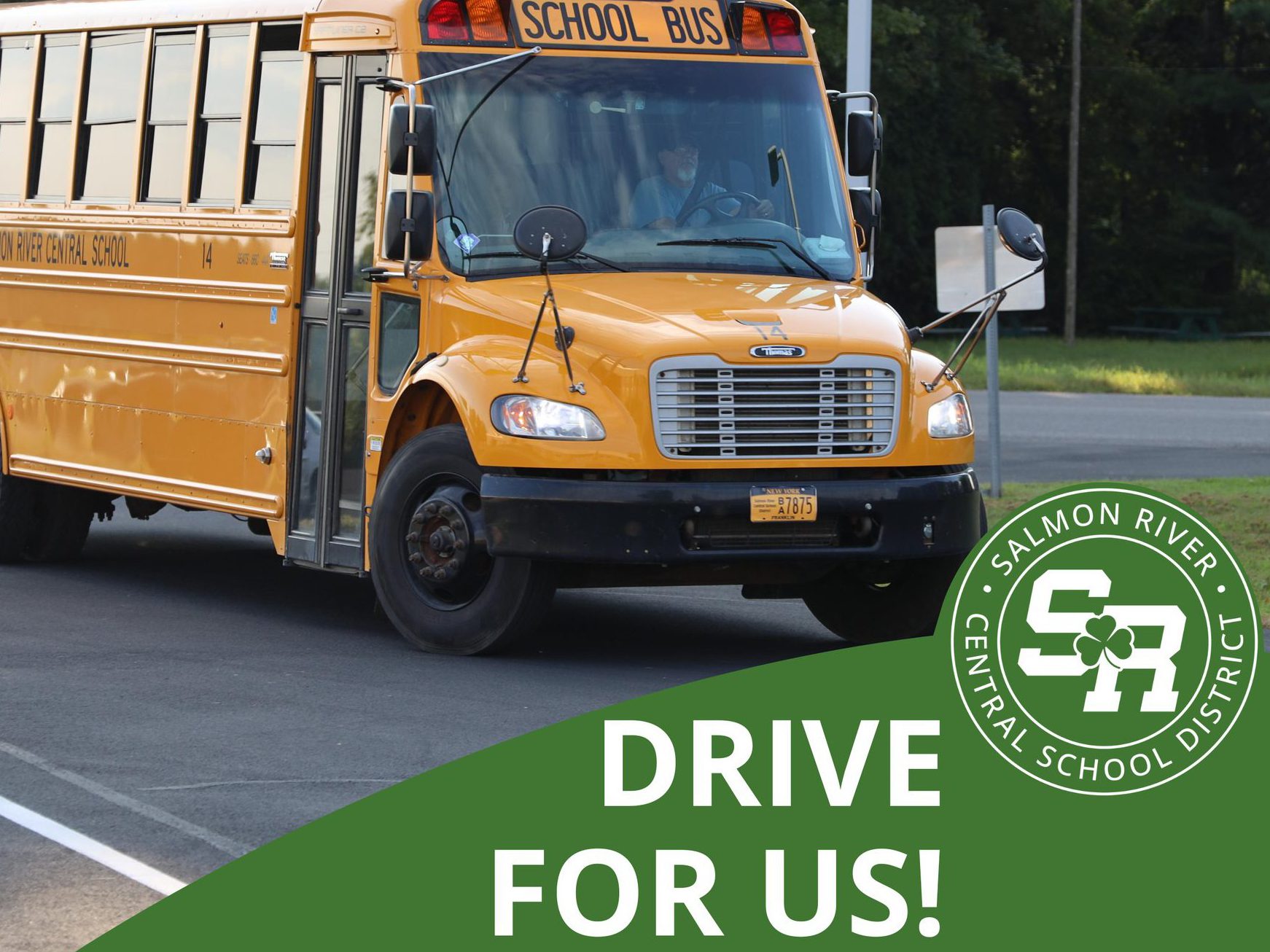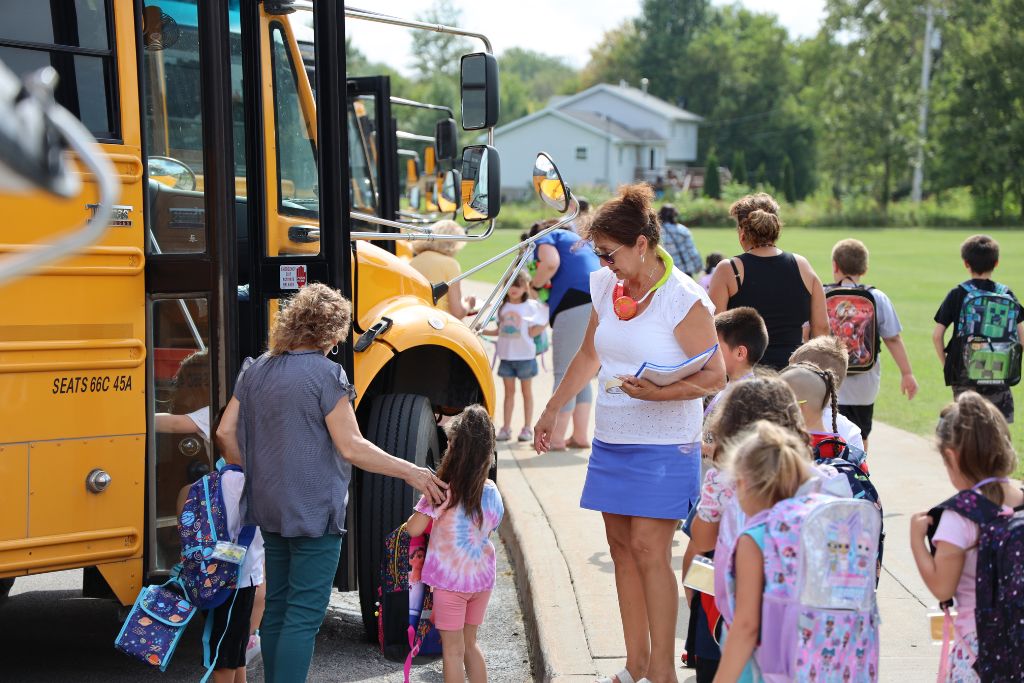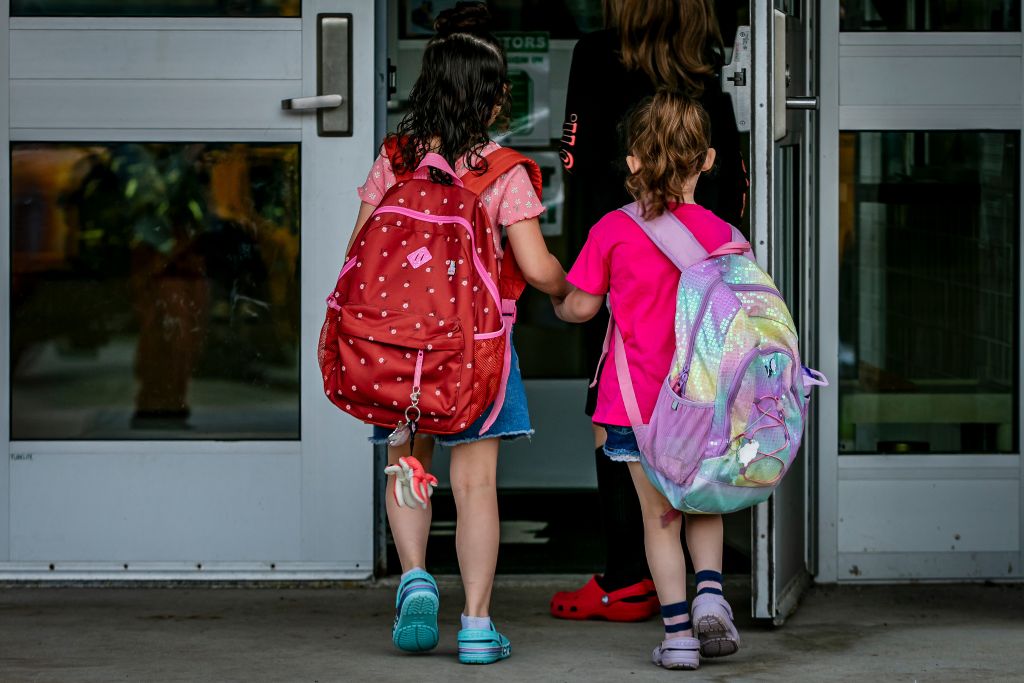
The Transportation Department is responsible for transporting more than 1,300 students to and from school, field trips, and athletic competitions.
Safety is a top priority. Driver training, student safety drills, and safety awareness programs are all emphasized to promote school bus safety.
Transportation Request | Closings & Delays | Transportation Procedures | Regulations for Driving to School | Idling School Buses | Routes | Work in Transportation
Transportation Request
Please fill out the Transportation Request Form to specify where you would like your child(ren) to be picked up and dropped off.
The Salmon River School District will allow each student in elementary school (Pre-K through Grade 5) to have two different addresses listed for pick up and/or drop off.
Example: Home in the morning and grandparents or daycare in the afternoon.
All Middle/High School students are allowed only one pickup/drop off address.
Closings & Delays
Announcement Information
If the school system is to be closed because of inclement weather or some other emergency, there will be a bulletin broadcast over the following local radio stations:
- WMSA-1340 AM
- WVNV-96.5 FM
- WICY- 1490 AM
- CKON-97.3 FM
- NCPR-90.9 FM
The information will also be posted on the district website and on the WPTZ-TV NBC5 website.
Delay Bell Schedule
Middle School & High School One Hour Delay
Period 1: 9:09am-9:45am
Period 2: 9:48am-10:21am
Period 3: 10:24am-10:57am
Period 5: 11:00am-11:33am
Period 6: 11:36am-12:09pm
Period 7: 12:12pm-12:45pm
Period 4: 12:48pm-1:21pm
Period 8: 1:24pm-1:57pm
Period 9: 2:00pm-2:33pm
Middle School & High School Two Hour Delay
Period 1: 10:09am-10:34am
Period 2: 10:37am-11:02am
Period 3: 11:05am-11:30am
Period 5: 11:35am-12:05pm
Period 6: 12:08pm-12:38pm
Period 7: 12:41pm-1:11 pm
Period 4: 1:14pm-1:39pm
Period 8: 1:42pm-2:06pm
Period 9: 2:09pm-2:33pm
View all Salmon River Middle & High School Bell Schedules.
Transportation Procedures
Our District allows each student in Elementary School (Pre-K through 5th Grade) to have two different addresses listed for pick up and/or drop off. All Middle/High School students are allowed one pick up/drop off address. A Transportation Request Form needs to be filled out with their building principal’s office to clearly state the schedule needed or when changes take place. Bus Passes will not be allowed for any addresses other than what your student was signed up for on their Transportation Form.
If a student’s primary home address is located on the Canadian side of our district they will choose a pickup point to be used as their pickup and drop off address. We are unable to pick up house-to-house on the Canadian side routes.
Student Bus Riding Rules
A student who is riding a school bus must assume certain safety responsibilities the “Rules”. The bus driver will have complete authority while the students are on the bus. Students and parents are reminded that bus transportation is a privilege which may be suspended due to student’s violation of the rules set forth herein.
The following rules of conduct will apply to ALL students riding on school buses:
- Students should be ready for the bus at least 10 minutes prior to pick up time and outside visible 5 minutes prior to pick up time. The bus will come to a complete stop with their air brakes engaged at each house and/or bus stop on their route for the count of 10 seconds or until they visibly see a parent and/or student heading towards the bus. If the student is visible and heading towards the bus within 10 seconds, the driver will wait for them to board the bus before proceeding to the next stop. If an individual is not visible within the 10 seconds they will continue along the route.
- Students will cross the highway following correct procedure, and driver instructions. Upon entering or exiting the bus, students will go in turn and avoid pushing, will take their assigned seats promptly and remain seated until the bus arrives at their stops.
- Students will keep their feet and other items out of the center aisle.
- Students will not shout, call, or throw anything out the windows, or put any part of their bodies out the windows.
- Students will avoid excess noise and use of obscene language, which might distract the driver, will be respectful to all staff members, and will respond promptly to the bus driver’s instructions. The driver has the sole right to assign seats.
- Students will not eat or drink, use or possess any tobacco products, alcoholic beverages or illegal substances on a school bus at any time.
- Students personal property must be kept in a safe place or left home. The school will not be responsible for any lost or stolen items.
- Cell phone use is strictly prohibited on the bus for making phone calls and/or taking pictures. Cell phone use will be allowed ONLY for reporting an emergency or arranging parents transportation after a sports run or a late arriving field trip.
Bus Safety
“Is my child safe on the school bus?” That question is one that every parent has a right to ask. The answer, according to the Federal Department of Transportation, is an emphatic “yes.” Statistically speaking, the school bus is one of the safest means of transportation – even safer than the family car.
Several factors combine to give school buses their reputation for safety. Chief among them are the extensive licensing and education credentials required of school bus drivers. Another is the fact that school buses themselves are sturdy vehicles.
Our bus drivers do their best to maintain order and ensure a safe trip. But they cannot do the job alone – it takes the cooperation of children, parents, and staff.
So what can parents do to make their child’s bus ride a safe experience?
- Make sure your child gets to the bus stop at least ten minutes before the bus is supposed to arrive and dress them properly in the event of bad or inclement weather. Above all else, tell your children never to run after a missed school bus – doing so can be dangerous!
- If your child has to cross a street either before getting on or after getting off the bus, instruct him or her to wait for the driver to give the crossing signal.
- Talk to your child regarding staying a safe distance from the bus when waiting to board and when departing the bus. Students should stay back at least 15 feet from the road as the bus pulls up to their stop. If they need to cross the road to board and after departing the bus, cross at least 10 feet in front of the bus. Students should always cross in front of the bus and NEVER cross behind a bus.
- Stress safety over forgotten clothing or lost homework. Children should never reach for anything (i.e. a dropped homework paper, book, glove, etc.) that has fallen beneath the bus. Likewise, they should not attempt to go back on the bus for a forgotten item. Many children will do this because they are afraid they will be in trouble. Parents can help by assuring them that it’s more important to be safe.
- Remind children to obey the bus driver – stay seated when the bus is in motion, talk quietly, keep the aisles clear of books, arms and legs, and show respect to the driver and their fellow passengers.
Remember – a safe and enjoyable bus ride makes for a great start and end to any school day.
Bus Conduct Reports
Violations of rules of bus transportation may require the driver to issue a bus conduct report, which shall be sent to the student’s administrator. The administrator shall then investigate the precipitating cause for the student’s violation of the rules set forth herein.
The administrator or the superintendent of schools may temporarily suspend the student from riding the bus pending the conference of the above-named parties and the administrator shall notify the student’s parent or guardian prior to such suspension.
Carry-On Regulations
We fully support any and all school sanctioned activities, however not all activities can always be supported by school transportation. The following guidelines have been established by state and school officials to insure rider safety:
- Potentially dangerous items may not be carried on a school bus. This includes items such as weapons, ammunition, flammable liquids, animals, items made out of glass and pressurized containers such as insect repellents and spray paints. Any items larger than can fit on your child’s lap.
- Large sports equipment, large poster boards, and large musical instruments will not be permitted unless permission is obtained by the Transportation Supervisor, and is dependent on the space, number of students on the bus, and the items do not jeopardize the safety and comfort of the students carrying them or any other rider on the bus.
Implementation of these safety regulations requires sound judgment by bus drivers. Their decisions will be influenced by the availability of space and the number of students riding on a school bus at any given point in time.
Permanent Transportation Changes
Please submit all permanent changes in your child’s pick-up/drop-off locations in writing to your child’s school directly. You must complete and submit a Transportation Form. Verbal requests will not be accepted.
Elementary Bus Stop Responsibilities
It is the responsibility of each and every parent/guardian, or designee, to be in attendance at the drop off bus stop location of all K-5 students in the Salmon River Elementary and St. Regis Mohawk School.
A parent or guardian must be visible at the drop-off point. If no one is visible at the drop-off point, the Bus Driver WILL NOT be allowed to drop students off. The student will be transported back to the campus and transferred to the appropriate School Administrator. The parent/guardian will then have the responsibility to transport the student home after signing the student off campus from the appropriate administrator.
A parent/guardian may request in writing an exemption to this requirement. The written request must be made for each individual student. The request will be reviewed by the appropriate School Administrator and filed in the office. A copy of the signed request will be forwarded to the Transportation Department. The School District requires annual updates to this exemption; arrangements from previous school years will not be honored without re-authorization.
Is your child’s bus late?
We work very hard to keep our buses on schedule. Under normal circumstances your student can expect the bus within 1-2 minutes of its normal time.
If your student’s bus is late it is most likely for one or more of the following reasons:
- Traffic delays.
- Weather and/or road conditions.
- Delays caused by the bus waiting for students not ready at their bus stop. Delays due to a substitute driver not familiar with the route.
- Delays caused by mechanical problems.
Please do not call the bus garage unless your student’s bus is more than 10 minutes late.
What training does your bus driver have?
To become a school bus driver, drivers must acquire a Commercial Drivers License with a School Bus, Passenger and Air Brake endorsement.
To gain and maintain this license and endorsement:
- They must pass 4 extensive written tests to get their permit. These tests included knowledge of school buses, air brakes, NYS driving laws, commercial vehicles, safety, and more.
- They must pass a NYSDOT physical and initial drug test.
- They must receive fingerprint clearance through BCI and FBI.
- They must take an Article 19-A road test using a full size (66 passenger) school bus.
- They must take a 3 hour pre-service training.
- They must pass a DOT School Bus Physical Performance Test.
- They must take a 30 hour NYSED School Bus Driver Training Course.
Continuing requirements, some annual and some biennial:
- Two NYSED Bus Driver Refresher courses annually.
- DOT Physical annually.
- NYSED School Bus Physical Performance Test biennially.
- An Article 19-A Behind-the-Wheel Driving Test biennially.
- An Article 19-A Defensive Driving Test annually.
- Take a Article 19-A Written Test biennially.
- Submit to random drug and alcohol testing.
- Article 19-A Driving Record Review annually.
Motorist Responsibilities
When approaching a school bus, a motorist must:
- Be Prepared: be prepared to stop if the school bus stops for a pickup or drop off.
- Slow down: Flashing yellow lights warn that the bus is about to stop. You should begin to slow your vehicle and prepare to stop.
- Stop: Red lights signal that all traffic must stop from either direction.
- Proceed: Only when the red lights are turned off.
- Be aware: Children may be approaching a stopped school bus from any direction or they may need to cross the road after exiting a stopped school bus.
- Remember: School buses cannot turn right on red while transporting students and must stop at all railroad crossings.
NOTE: It is illegal to pass a stopped school bus on a road, on school property, or at any location when its red lights are flashing. If convicted of passing a stopped school bus, the minimum fine is $250–400 and/or 30 days in jail for the first offense. Drivers convicted of passing a stopped school bus will also receive a 5-point infraction on their license for each violation. This law is strictly enforced and all violators will be fully prosecuted.
Regulations for Driving to School
All students are to ride the bus unless they have completed the proper paperwork with the office and have been given their school issued driving permit. The New York state education law charges each school with the responsibility of all motor vehicles on its premises. In view of this fact, it is our desire to have record of all student drivers and to inform them of regulations for proper and safe operation of vehicles on school property.
Due to a limited number of parking spaces, permission to drive may be given only to Grade 12 and National Honor Society students in Grade 11. Underclassmen must demonstrate that there is a need to drive to school. Students are to schedule a time to meet with the principal to discuss the necessity to drive to school. They must provide a proof of license, registration, and insurance card. Both the student and parent/guardian must sign and return a permission form to the high school office. Students will be assigned to a designated parking area.
Idling School Buses on School Grounds
The Board of Education recognizes the need to promote the health and safety of District students and staff and to protect the environment from harmful emissions found in bus and vehicle exhaust. In accordance with Education Law and Commissioner’s Regulations, the District will minimize, to the extent practicable, the idling of all school buses and other vehicles owned or leased by the District while such bus or vehicle is parked or standing on school grounds or in the front of any school. This policy also applies to contractor owned and operated school buses under contract with the District.
The District shall ensure that each driver of a school bus or other vehicle owned, leased or contracted for by the District turn off the engine of the bus or vehicle while waiting for passengers to load or off load on school grounds, or while such vehicle is parked or standing on school grounds or in front of or adjacent to any school.
Access more information from Board Policy 5731 IDLING SCHOOL BUSES ON SCHOOL GROUNDS.
District Services Links
Transportation
Jocelyn Black
Transportation Supervisor
Phone: (518) 358-6684
Shayna Travers
Transportation Clerk
Phone: (518) 358-6692
Bus Routes
Information on bus routes is distributed by the Transportation Department. For safety purposes, we do not post bus routes on the district website.
Please write down your child’s bus number for easy access in case you need to communicate with the Transportation Department. Parents are also encouraged to learn the name of their child’s bus driver.

Work in Transportation
Help transport your children, grandchildren,
nieces, nephews, cousins or fellow
community members to and from school!
The Salmon River Central School District Transportation Department is always looking for community members to join our team.
If you are interested in applying, you can view the job postings and submit your application online.
Transportation By The Numbers
1,400 +
Students Transported Daily


400,000
Miles Driven Annually
50
School Buses


97.92%
Department of Transportation Passing Rate